Book
Reviews and reading notes. I write about thought‑provoking books like Notes on Complexity, read children’s books with my son and even list the titles I keep stocked in my office to recommend to colleagues.
Into the Wild by Jon Krakauer
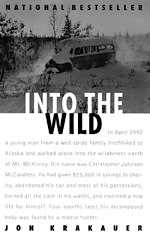
I finished Into the Wild by Jon Krakauer this evening. It was enjoyable to both start and finish this book during our stay at Glacier National Park. Reading that much is just one of the joys of not having any television or Internet access in our cabin. I was excited to read this book after having watched the movie version of Into the Wild. My friend Kent lent me his copy of the book and it’s already been passed on to Tammy to read before returning to Kent.
First off, this is a really enjoyable book and just like the other Krakauer book I’ve read, Into Thin Air, this is a real page turner. Even a slow reader like myself can’t help but finish it quickly, picking it up at every opportunity to see what happens next.
For a full review of the book or to dive into it’s topics, check out the Amazon reviews or just read it yourself. I think most people will enjoy it.
The whole story of Chris McCandless, aka Alexander Supertramp, really grabbed me. Kent and I talked about this at some length because he had the same reaction. His story is beyond interesting, and I find it impossible to think about his story without also reflecting on my own life. I think that there is something about the ferocity that Alex lived and dreamt that makes me, something.
That’s the thing about Alex’s story. On one hand, he’s incredibly selfish. His entire pursuit is so inwardly focused and causes a lot of pain for most anyone that got close to him. He goes completely off the deep end, and in the end loses his life foolishly. With some basic preparation and know how he probably would have survived his ordeal in the Alaskan Interior and nobody would have ever heard of Alexander Supertramp.
But even with those negatives, you feel a sense of admiration for the young man. A sense of pride. Or even a sense of shame for not having the courage or discipline to pursue something the way that he did, or even a fraction of the way that he did.
Have any of you read this book? I would be curious to know what you thought of it and what your reaction was. I think that Chris’ story is going to sit with me for a while.
In Defense of Food - An Eater's Manifesto
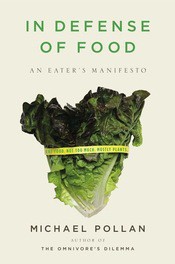
I just finished reading Michael Pollan’s newest book, In Defense of Food: An Eater’s Manifesto. It is a well-written and well-researched book that dives into the Western diet and deconstructs it in three parts: The Age of Nutrionism, The Western Diet and the Diseases of Civilization, and Getting Over Nutritionism. I’ve heard this book referred to as the follow-on to his wildly popular The Omnivores Dilemma (which, in full disclosure I have not read, yet).
I found In Defense of Food particularly interesting in part because of my own view of food and how it has evolved. A decade ago I was completely clueless about food. If I was asked how many calories were in a cheeseburger I could have easily agreed with 100 or 4,000. I really had no idea. Then while focusing extensively on fitness and diet I started logging every bit of food that passed my lips. I was focused in a nearly obsessive manner (nearly? who am I kidding) on how many grams of various macronutrients I got and precisely how many calories I consumed. To put a point on it, I weighed my fruit on a gram scale before and after eating it to determine the precise intake. Yeah, that is obsessive.
This is not behavior that you can model forever and when I stopped doing it I learned that I hadn’t really learned how to eat, but instead had become a discipline of nutritionism. Nutritionism is not Pollan’s term, it was coined by Gyorgy Scrinis. The behavior and mindset that it describes though is the antithesis of the most basic suggestion on how to eat.
Eat food. Not too much. Mostly plants.
Those are the first seven words in Pollan’s book and admittedly you could stop reading there. The remaining 200 pages dive into the details of the Western diet and the issues with it. Pollan’s writing is interesting throughout and even the deeper dives into the roots of nutritionism are immensely interesting. He does a great job of highlighting for the reader just how much our food system has changed, and in most ways for the worse, in the last 70 years. This paragraph really hit me hard. I expected corn and high-fructose corn syrup to be the evil doer in this book, but the bases of nutritionism predates that trend.
Of all the changes to our food system that go under the heading “The Western Diet,” the shift from a food chain with green plants at it’s base to one based on seeds may be the most far reaching of all. Nutritional scientists focus on different nutrients – whether the problem with modern diets is too many refined carbohydrates, not enough good fats, too many bad fats, or a deficiency of any number of micronutrients or too many total calories. But at the root of all these biochemical changes is a single ecological change. For the shift from leaves to seeds affects much more than the levels of omega-3 and omega-6 in the body. It also helps account for the flood of refined carbohydrates in the modern diet and the drought of so many micronutrients and the surfeit of total calories. From leaves to seeds: It’s almost, if not quite, a Theory of Everything.
Throughout the book Pollan deals with the challenge of arguing nutritionism while not falling into the logic arguments it naturally suggests. I was happy to see him recognize this later in the book, and I thought it appropriate. After all, to have a book that suggests that you have to stop looking at food as grams of chemicals, and then just suggests that you start gardening would be incomplete and unhelpful.
The undertow of nutritionism is powerful, and more than once over the past few pages I’ve felt myself being dragged back under. You’ve no doubt noticed that much of the nutrition science I’ve presented here qualifies as reductionist science, focusing as it does on individual nutrients (such as certain fats or carbohydrates or antioxidants) rather than on whole foods or dietary patterns. Guilty. But using this sort of science to try to figure out what’s wrong with the Western diet is probably unavoidable. However imperfect, it’s the sharpest experiemental and explanatory tool we have. It also satisfies our hunger for a simple, one-nutrient explanation. Yet it’s one thing to entertain such explanations and quite another to mistake them for the whole truth or to let any one of them dictate the way you eat.
This is the heart of Pollan’s message. Stop thinking of food as a collection of micro- and macro-nutrients and instead think of it in the whole. This obsessive push to the one thing that will save us is destroying us.
Pollan doesn’t spare the establishment in his analysis. Early in the book he outlines legislation passed in 1938 under the Food, Drug and Cosmetic Act that required the word “immitation” appear on any food that was fake. I love the definition of this “…there are certain traditional foods that everyone knows, such as bread, milk and cheese, and that when consumers buy these foods, they shoudl get the foods they are expecting…” The sad thing is that nearly everything in the modern grocery store would have to be labeled immitation. The requirement was repealed shortly after enacted after protests from the food industry. Nobody apparently wanted to buy immitation spaghetti.
When corn oil and chips and sugary breakfast cereals can all boast being good for your heart, health claims have become hopelessly corrupt. The American Heart Association currently bestows (for a fee) its heart-healthy seal of approval on Lucky Charms, Cocoa Puffs, and Trix cereals, Yoo-hoo lite chocolate drink, and Healthy Choice’s Premium Caramel Swirl Ice Cream Sandwich – this at a time when scientists are coming to recognize that dietary sugar probably plays a more important role in heart disease than dietary fat. Meanwhile, the genuinely heart-healthy whole foods in the produce section, lacking financial and political clout of the packaged goods a few aisles over, are mute. But don’t take the silence of the yams as a sign that they have nothing valuable to say about health.
Pollan doesn’t leave it at just the food either, but the way in which we consume it. I was surprised by one of the statistics cited in the book, that 60% of McDonald’s revenue is made at the drive-through. A healthy meal is not consumed in your car. It may seem unachievable, but having a real family meal is a critical part of a healthy diet.
That one should feel the need to mount a defense of “the meal” is sad, but then I never would have thought “food” needed defending, either. Most readers will recall the benefits of eating meals without much prompting from me. It is at the dinner table that we socialize and civilize our children, teaching them manners and the art of conversation. At the dinner table parents can determine portion sizes, model eating and drinking behavior, and enforce social norms about greed and gluttony and waste. Shared meals are about much more than fueling bodies; they are uniquely human institutions where our species developed language and this thing we call culture. Do I need to go on?
Indeed he does not. In Defense of Food is a great read. If you question your approach to what you put on the table (or don’t put on the table), this is a good perspective on that challenge.
Moneyball
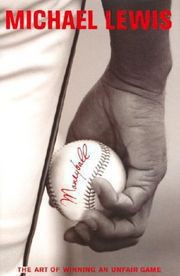
I just finished reading Moneyball. This book was recommended to me by a friend who really likes baseball and feels that it’s very odd that I don’t like baseball. You see, I love numbers. I love patterns. I love graphs. And according to Moneyball, baseball is all about numbers.
Moneyball was a really enjoyable book, and it succeeded in making me appreciate baseball a lot more and I will definitely enjoy the games even more. However, after reading it the main thing I was left with was how backwards the baseball establishment has been for so long. You mean that statistical analysis may help you determine how a player will perform? Wow. Stunning stuff.
The way Lewis writes this book makes it sound like there is a strict set of two camps. One that plays by look and feel, the other that plays by spreadsheets. I’m sure it’s not that simple, but it makes for a wonderful story and is very well written.
If you like numbers, and have much of any interest in baseball, you should take a read through Moneyball.
Read Sin City Volume 4: That Yellow Bastard. Thanks Lou!
The Earth Is Enough

I recently decided that I needed to re-read this book as well. Similar to A Walk in the Woods, I’d been reminiscing about what a great book this was when I read it a few years ago, and then found myself reading all the Harry Middleton books that there were. His style of writing is unique, and has a pace that some would find frustrating, but I found relaxing and broadly enjoyable. In many ways he reminds me of Norman MacLean, and that is a pretty big compliment.
Earth is Enough is a book about living life simply. It is the recounting of Middleton’s boyhood years living with his uncles in the mountains. It brings out the beauty in the simple, and the wonderment of the basic qualities of life. The cast of characters in the book are larger than life, and all have a lessen to tell.
This is a truly wonderful read, as are the other books in the series (Bright Country, On the Spine of Time). I think this is one that you get more out of every time you read it. And please remember to slow down and enjoy it.
Stiff
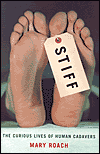
I just finished reading what has to be one of the stranger books I’ve read. Stiff is in a way like an owners guide for future cadaver owners. That is to say, all of us. Mary Roach goes into impressive, if not at times unsettling, detail about the processes by which cadavers contribute to education, safety and numerous other ventures. It is initially off-putting but after a few chapters is very interesting.
I found the references to pre-1900 practices of regarding cadavers to be alarming and the advancements of recent years interesting. Perhaps most interesting was the next to last chapter regarding ecological burial. Most interesting I think was understanding how radically different various cultures work with cadavers and in general human remains.
Interesting read, glad to have read it, don’t think I’ll read it a second time.
Harry Potter and the Order of the Phoenix

I think it was three years ago that I caught the Harry Potter bug. In a matter of a couple of months I had read the four books that were available and loved every page. Yes, it’s a kids book. But the story is just great.
I was very excited when the fifth book, the Order of the Phoenix, came out. I had pre-ordered it at least a year in advance on Amazon.com and it seemed like forever to wait. When I got the nearly 900 page tome I started reading it right away.
But then something happened. For the first time ever I wasn’t all that excited to read it and it sat on my nightstand for months. I finally picked it back up and got infected with the Potter frenzy again.
The book was a great read. Very enjoyable (even with a 6 month pause in the middle). Clearly the story is evolving to even bigger and bigger levels. Now the wait begins for Harry Potter and the Half Blood Prince!
The Metabolic Plan
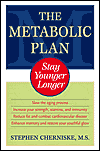
My friend Phil recommended The Metablic Plan by Stephen Cherniske to me recently and I just finished reading it. After reading the first 50 pages I had to give him some grief for recommending this “overzealous” book on anti-aging however I recommend you do as I did and continue reading on. This book has some very good insight into the process of aging, what happens in your body and how you can fight off the negative (catabolic) effects of aging not with the intent of living forever but instead with the intent of enjoying your later years to the maximum of benefit.
I found the explanation of the aging process to be interesting and enlightening. I hadn’t taken into account the aspects of aging thinking not about me as an individual but the human race as a species and how we are programmed. This book would probably be lost on people in their 20s (you’ll live forever after all, right?) but for those in there 30s and with an eye on maximizing possibilities it is a good read. It’s also a good read for those in their 40s, 50s or 60s as much of the information can improve your quality of life at any time.
The author is a strong proponent of supplementing DHEA. I always get worried when someone is so vocally supportive of a supplement, however, he properly warns about dosage and when and for what purpose it should be used. Unfortunately, there will always be some fool that takes 300mg instead of the 25mg recommended and has some bad reactions.
Some links to information from the book (mostly for my benefit to refer to later!):